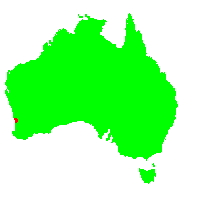General Description:
Banksia laricina is a shrub to 2 metres tall. The linear leaves are green and measure 5 to 15 mm long by 0.8 mm wide. The obovoid inflorescences are seen in autumn and winter and are about 5 cm wide at flowering, occurring on short lateral branchlets. They are yellow-fawn in colour and are often held within the foliage.
The species is non-lignotuberous and fire-sensitive; plants rely solely on seed for regeneration after bushfires. The seeds are enclosed in prominent follicles, which are bright green when new, attached to a woody cone and are generally retained within the cone until burnt. The shape of the cone gives rise to the common name ‘rose-fruited banksia’ because it is reminiscent of rose petals – unlike those of any other banksia.
Although much of the species distribution is in a conservation reserve, its range is only around 35 km. Also, wild plants are harvested for their fruiting cones, further putting the plant at risk. Thus its long term survival requires long term monitoring in the wild to prevent exploitation.
B.laricina is rarely cultivated but should require a Mediterranean climate (i.e. wet winter, dry summer) and sandy soil to do well. In common with other western banksias, the species is likely to be difficult to establish in areas with humid summers.
Propagation from seed is relatively easy.
* EPBC Act = Environment Protection and Biodiversity Conservation Act 1999;
ROTAP = Rare or Threatened Australian Plants (Briggs and Leigh, 1988)
For further information refer the Australian Plants at Risk page

Banksia laricina
Photo: Matt Denton
 Australian Native Plants Society (Australia)
Australian Native Plants Society (Australia)